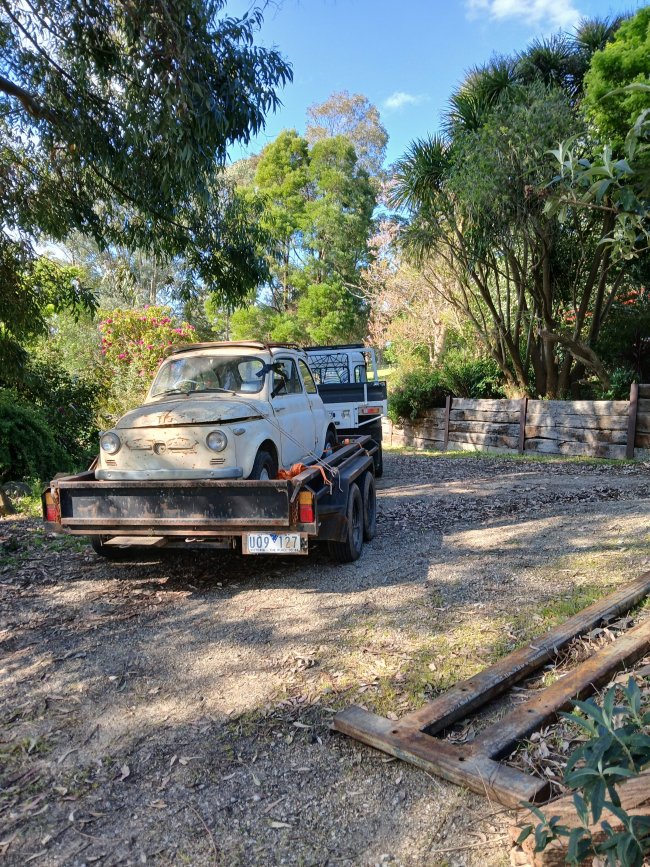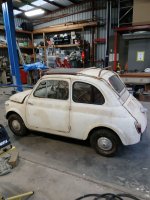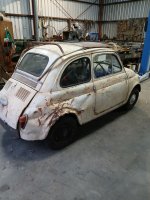Introduction
I promised to start a restoration thread on my 1959 Nuovo. I also promised it would be a slow process...
I'm located in the Gippsland region of the state of Victoria, Australia. I retired around 18 months ago and decided it would be a great idea to do a classic car restoration as a long-term, when-I-feel-like-it kind of project. Don't know what decided me on a Cinquecento but once the idea took root, nothing else was in the running.
I got a lead on a 1961 car that sounded reasonable but the owner ended up giving it to his brother before I even got a look at it. Another lead on a 1959 car that had been sitting under a lean-to on the side of the owner's shed for at least 10 years and had sat under a tarp for another ten years before that. I went and had a look, wasn't very impressed by what I saw- lots of rust, missing trims and a passenger seat, a makeshift luggage rack WELDED to the roof gutters, body damage etc but it WAS a Cinquecento, it had matching numbers and SUICIDE DOORS!! How cool is that? My legs would look so good swinging out of that. The owner said he would talk to some friends and come up with a price.
The next lead I got was on a 1969 car in South Australia (a different state). It belonged to an old bloke, it had been his mother's car, he had parked it in the shed in about 1986 and had driven it out again last week after changing the oil and cleaning the points. I spent a day, flew over there and hired a car, went and had a look at the Cinq. The asking price was a little high as the car was a runner. The shed it had spent the last decades in was 900 meters from the ocean and was missing several wall sheets. Potentially just as rusty as the other car, being a runner was not important to me as I planned a nut-and-bolt resto either way.
I called the owner of the 1959 car and we eventually agreed on a purchase price that neither of us was happy with (seemed fair) and agreed to sort it out when we both got home from our holidays. A couple of weeks later I borrowed a trailer (mine was about 4" short) and went and collected the car.





I'm located in the Gippsland region of the state of Victoria, Australia. I retired around 18 months ago and decided it would be a great idea to do a classic car restoration as a long-term, when-I-feel-like-it kind of project. Don't know what decided me on a Cinquecento but once the idea took root, nothing else was in the running.
I got a lead on a 1961 car that sounded reasonable but the owner ended up giving it to his brother before I even got a look at it. Another lead on a 1959 car that had been sitting under a lean-to on the side of the owner's shed for at least 10 years and had sat under a tarp for another ten years before that. I went and had a look, wasn't very impressed by what I saw- lots of rust, missing trims and a passenger seat, a makeshift luggage rack WELDED to the roof gutters, body damage etc but it WAS a Cinquecento, it had matching numbers and SUICIDE DOORS!! How cool is that? My legs would look so good swinging out of that. The owner said he would talk to some friends and come up with a price.
The next lead I got was on a 1969 car in South Australia (a different state). It belonged to an old bloke, it had been his mother's car, he had parked it in the shed in about 1986 and had driven it out again last week after changing the oil and cleaning the points. I spent a day, flew over there and hired a car, went and had a look at the Cinq. The asking price was a little high as the car was a runner. The shed it had spent the last decades in was 900 meters from the ocean and was missing several wall sheets. Potentially just as rusty as the other car, being a runner was not important to me as I planned a nut-and-bolt resto either way.
I called the owner of the 1959 car and we eventually agreed on a purchase price that neither of us was happy with (seemed fair) and agreed to sort it out when we both got home from our holidays. A couple of weeks later I borrowed a trailer (mine was about 4" short) and went and collected the car.






